| |
|
|
VIVID DANCER
Argia vivida
|

|
photo (above) Frog
Pond 6 Jul 2006
photo (below) Laguna Grande 19 Jul
2006
|
| Vivid Dancer is probably the most common
and widespread ode in Monterey
County. It can be abundant in any wooded or shady habitat with water
nearby.
A walk around the Frog Pond Reserve in Del Rey Oaks in July, for
example,
will produce hundreds, maybe thousands. The story is the same for many
other local parks. And yet most folks walking the trails won't notice
these
inch-long colorful sprites. |
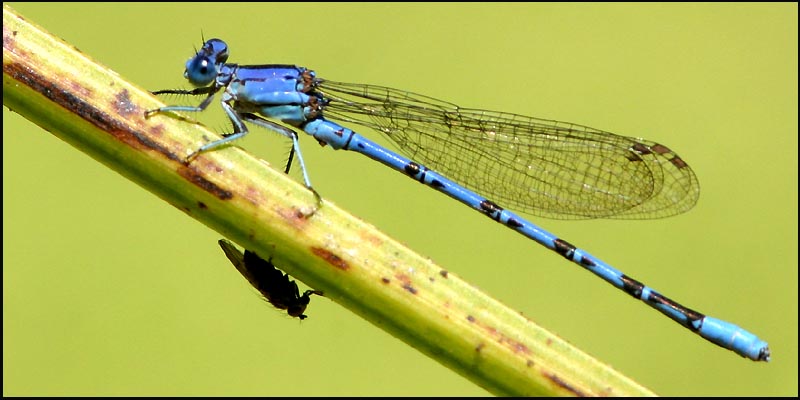
|
Males are vividly patterned in rich blue
(with a slightly violet
tinge); most females are garbed in a dull tan to chalky white (below
right).
Both sexes, however, are identified in the field by the backwards
pointing
arrowheads on the middle abdomen segments, between the bands of black.
Note also the broken side-stripe on the thorax, while a thick
double-stripe
lies atop the body.
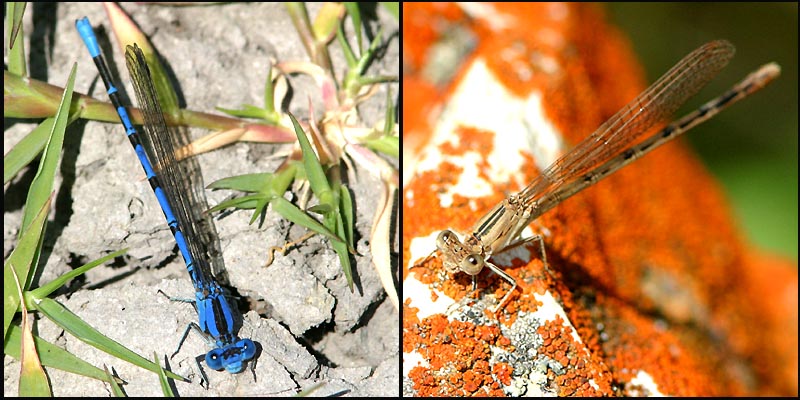
photo (above L to
R) 3 Sep 2006 Frog Pond
& 30 Jul 2006 w. Pinnacles NM
photo (below) 19 Jul 2006 Laguna
Grande
|
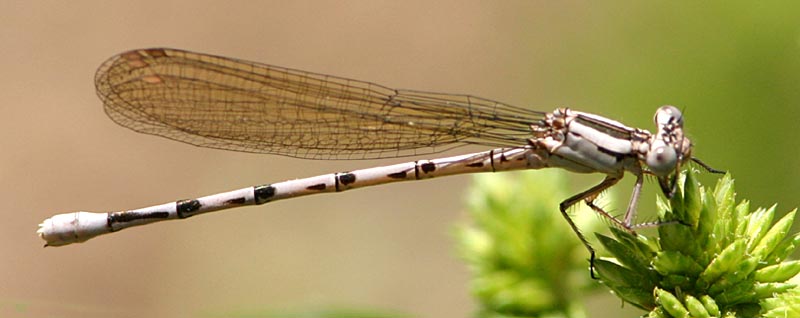
| Female Vivid Dancers come in two types: the
pale gynomorphic form (above)
and the blue-and-black andromorphic form that mimics the male pattern
(below;
note ovipositor) |

photo (above) 3
Sep 2006 Soberanes Creek
|
|
photo (below) 6
Jul 2006 Frog Pond Reserve,
Del Rey Oaks
 |
In either case, males have no trouble
locating the female, grabbing
her behind the neck (left; andromorphic female), and carrying her off
for
sex (below, with gynomorphic female — in wheel). |

photo (above) 23
Sep 2006 Wagon Caves, The
Indians
photo (below) 5 Jul 2006 Arroyo Seco
River
|
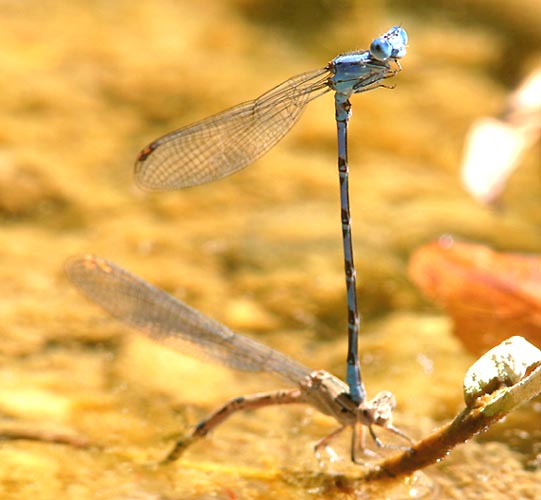 Among
the most engaging behaviors, though, is tandem ovipositing. The male
takes
the female to a spot of still water. Here he often balances above her,
by grasping her mesostigmal plate (left), while she oviposits the eggs
on vegetation below waterline. In a river with strong currents, such as
the Arroyo Seco River where these pair were, the spot chosen is a very
shallow backwater at the edge of the river, well out of the main
current.
It has been hypothesized that males of species that regularly tandem
oviposit
in running streams and rivers (like Vivid Dancer) have paraprocts
better
designed for the necessary strong grasp against any current. Among
the most engaging behaviors, though, is tandem ovipositing. The male
takes
the female to a spot of still water. Here he often balances above her,
by grasping her mesostigmal plate (left), while she oviposits the eggs
on vegetation below waterline. In a river with strong currents, such as
the Arroyo Seco River where these pair were, the spot chosen is a very
shallow backwater at the edge of the river, well out of the main
current.
It has been hypothesized that males of species that regularly tandem
oviposit
in running streams and rivers (like Vivid Dancer) have paraprocts
better
designed for the necessary strong grasp against any current.
From a human perspective, it can be very amusing
and interesting to
watch several pairs of a species ovipositing in the same spot at the
same
time. The males of the two pairs on the Carmel River (below) appear to
be exchanging sports scores — while the female does all the hard work
(but
it even looks as if the ladies are finding time to gossip . . ).
|
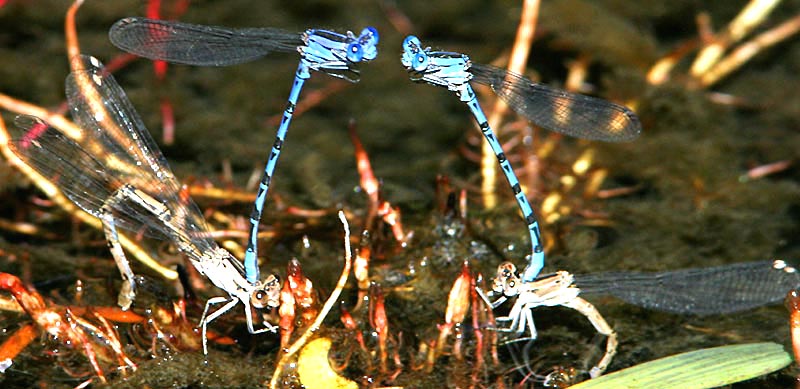
Photo (above) 7
Oct 2006 Carmel River at
Garland Ranch Regional Park
|
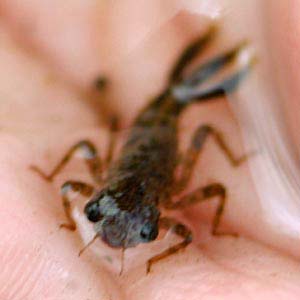 |
Of course all that sex will lead to babies.
. . er, in this case, eggs and then nymphs (left). Much of the odonate
life cycle occurs underwater. While adult damselflies live only a few
days or weeks, the young survive the winter in the muck at the bottom
of a stream or pond. The nymph shown is not a proven Vivid Dancer, but
it does seem to be in the genus Argia (per Dennis Paulson),
so Argia vivida is a good guess, given its abundance. The
three flanges at the end of the abdomen are external gills used to
breathe underwater by damselfly larvae. |
|
| Vivid Dancer is certainly widespread in MTY but
it does require some
shade. Habitats that are conducive include streams through Monterey
Pine
forests, oak woodlands, Redwood canyons, or willows, and mountainous
habitats.
There are at least 7 MTY specimens in 4 different collections, some
dating
back to 1940. |
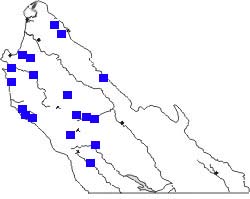 Vivid
Dancer is common and widespread. The map (right) shows some specific
locales
from which it is known — there are undoubtedly hundreds of other
locations
in the mountains or in woodlands anywhere. However, it appears to avoid
open country with little shade. For example, there are as yet no
records
from the Salinas River in the Salinas Valley. Vivid
Dancer is common and widespread. The map (right) shows some specific
locales
from which it is known — there are undoubtedly hundreds of other
locations
in the mountains or in woodlands anywhere. However, it appears to avoid
open country with little shade. For example, there are as yet no
records
from the Salinas River in the Salinas Valley.
Dates of MTY records range from 15 March to 7 October. This is similar
to elsewhere in California (Manolis 2003) although there are some
Jan-Feb records from southern California. |
|
|
Literature cited:
- Manolis, T. 2003. Dragonflies and Damselflies of
California. Univ. of
Calif.
Press, Berkeley.
Web resources:
Major identification web sites with much information on California
odes include:
For sites with excellent photos to compare for identification or to
simply
enjoy, see:
Many of these sites have links to other useful pages. Kathy Biggs's
site
is particularly useful in her selection of links. |
|
All photos © Don Roberson 2007
TOP
|
|
|
|
|
|
|
|
|
